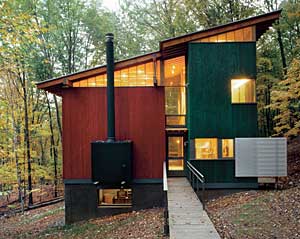New Paltz, New York
It would be easy to think of Bohlin Cywinski Jackson’s House at the Shawangunks—located a few miles west of the Hudson River in the hills near the upstate New York town of New Paltz—as a house designed for rock climbers. Granted, the clients—a husband and wife who left New York City—enjoy rock climbing and moved there in part to be within walking distance of cliffs. And the primary organizing strategy of the house is a light-filled central stair that connects three floors, capped by a ladder to an attic loft. But aside from these details, this analogy oversimplifies the house’s relationship to its sloped site.
As the architect Peter Bohlin, FAIA, puts it, up was the only way to go. Since the foundation needed to be close to 4 feet deep, on a substantial slope for a house with a basement, curtailing the foundation’s cost meant minimizing the overall footprint. As a result, even on its heavily wooded 6-acre site, the 2,100-square-foot house appears somewhat diminutive. Its vertically arranged program includes living and dining rooms, a kitchen, and a bathroom on the first floor; a master bedroom and bath, as well as a balcony office, on the second; the attic loft for an office and storage; and a basement with a media room, guest bedroom, bath, and utility room.
All of this is arranged in a series of cubes—the basement with a gray-stained concrete base, the living room with red-stained Western red cedar shiplap siding, and the kitchen and second floor with a green-stained version of the cedar. A dining room, entirely clad in glass, stands in for a porch. The wood-framed cubes support the single-pitch metal roof, which follows the slope of the site and is secured to the cubes with framing clad in translucent polygal panels that reinforce the relatively simple geometries of the house’s volumes.
While the tight plan of the house relies on a fairly conventional arrangement of spaces, in section the architects designed each room with view windows and clerestories that rather elegantly correspond to the specific conditions of the site. Walking from the raised wood sidewalk of the entrance and into the double-height living room, it’s not only the large window opening to the southeast, down the site, that attracts you, but also the view opposite, overhead and up to the underside of the top edge of the roof. With sunlight pouring through in various ways all day, these clerestories help to embed the house further into the rhythms of the forest.



Post a comment to this article
Report Abusive Comment